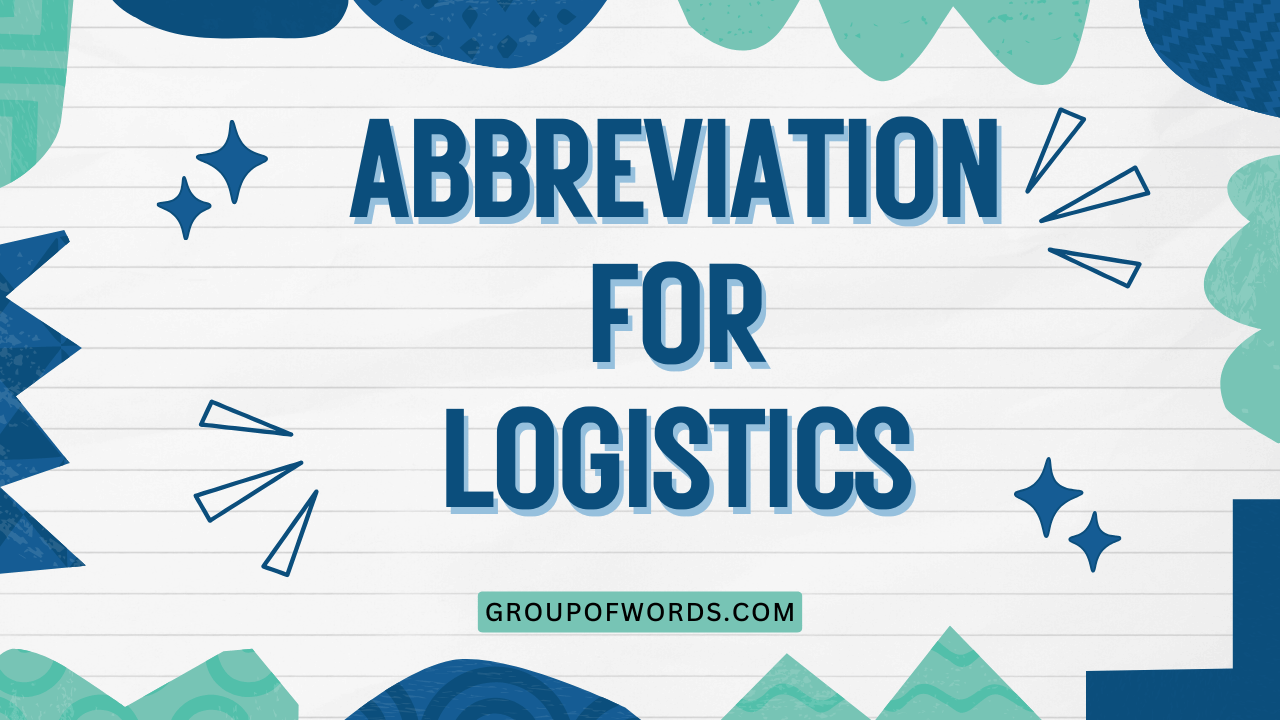Abbreviations in Logistics: A Comprehensive Guide
Understanding abbreviations is crucial in the fast-paced world of logistics. They streamline communication, save time, and increase efficiency.
This article provides a comprehensive guide to logistics abbreviations, covering their definitions, usage, and common pitfalls. Whether you’re a student, a logistics professional, or simply interested in the field, this guide will equip you with the knowledge to confidently navigate logistics terminology.
Table of Contents
- Introduction
- Definition of Logistics Abbreviations
- Structural Breakdown of Logistics Abbreviations
- Types of Logistics Abbreviations
- Examples of Logistics Abbreviations
- Usage Rules for Logistics Abbreviations
- Common Mistakes with Logistics Abbreviations
- Practice Exercises
- Advanced Topics in Logistics Abbreviations
- Frequently Asked Questions (FAQ)
- Conclusion
Introduction
In the intricate and dynamic field of logistics, effective communication is paramount. Abbreviations play a vital role in enabling this efficiency, allowing professionals to convey complex information quickly and accurately.
However, the sheer volume of abbreviations can be daunting. This article aims to demystify logistics abbreviations, providing a detailed explanation of their formation, usage, and potential pitfalls.
Mastering these abbreviations is essential for anyone involved in supply chain management, transportation, warehousing, or any related field. This guide will serve as a valuable resource, improving your understanding and communication skills in the logistics industry.
Definition of Logistics Abbreviations
Logistics abbreviations are shortened forms of words or phrases commonly used in the logistics industry. These abbreviations are designed to save time and space when writing or speaking about complex logistics processes, terms, and entities.
They are a form of shorthand that allows logistics professionals to communicate more efficiently, both internally and with external partners. Understanding these abbreviations is critical for effective communication and avoiding misunderstandings.
Logistics abbreviations can be classified based on their function and the type of term they represent. They can refer to transportation modes, inventory management techniques, organizational roles, or specific documents and processes.
For example, “LTL” stands for “Less-Than-Truckload,” a common shipping method. “FIFO” represents “First-In, First-Out,” an inventory valuation method.
“COO” stands for “Country of Origin,” an important detail for customs and trade compliance. The function of an abbreviation often dictates its context and meaning.
The context in which an abbreviation is used is crucial for its correct interpretation. The same abbreviation can have different meanings depending on the specific area of logistics being discussed.
For instance, “ETA” commonly means “Estimated Time of Arrival” in transportation, but it could also refer to “Economic Trade Agreement” in a broader trade context. Therefore, it’s important to consider the surrounding information to determine the intended meaning of a logistics abbreviation.
Misinterpreting an abbreviation can lead to errors, delays, and costly mistakes in logistics operations.
Structural Breakdown of Logistics Abbreviations
Logistics abbreviations are typically formed using a few common methods. Understanding these methods can help you decipher unfamiliar abbreviations and even create your own when necessary.
- Acronyms: These are formed by taking the first letter of each word in a phrase and combining them to create a new word. For example, NAFTA stands for North American Free Trade Agreement.
- Initialisms: Similar to acronyms, initialisms use the first letter of each word in a phrase, but the letters are pronounced individually. For instance, LTL stands for Less-Than-Truckload.
- Shortenings: Some abbreviations are simply shortened versions of words, such as “pkg” for “package” or “qty” for “quantity.”
- Contractions: These involve removing letters from within a word, such as “mfr” for “manufacturer.”
The structure of an abbreviation often provides clues about its meaning. For example, abbreviations that end in “O” frequently refer to an organization or office, such as “COO” for Country of Origin or “CFO” for Chief Financial Officer (which can be relevant in the financial aspects of logistics).
Similarly, abbreviations that include “T” often relate to transportation, such as “TEU” for Twenty-foot Equivalent Unit or “TMS” for Transportation Management System.
It’s also important to pay attention to capitalization. Some abbreviations are always capitalized, while others are written in lowercase.
Generally, acronyms and initialisms are capitalized, while shortenings and contractions may be lowercase. However, there are exceptions to this rule, so it’s always best to double-check the correct capitalization of an abbreviation if you’re unsure.
Consistent and correct capitalization enhances clarity and professionalism in logistics communication.
Types of Logistics Abbreviations
Logistics abbreviations can be categorized based on the area of logistics they relate to. This categorization can help you learn and remember the abbreviations more effectively.
Transportation Abbreviations
These abbreviations are used to describe modes of transportation, shipping terms, and transportation-related documents.
Warehousing Abbreviations
Warehousing abbreviations are used to describe warehouse operations, inventory management techniques, and warehouse equipment.
Inventory Management Abbreviations
These abbreviations relate to inventory control, valuation methods, and stock levels.
International Trade Abbreviations
International trade abbreviations are used in import/export operations, customs documentation, and international trade agreements.
General Logistics Abbreviations
These abbreviations are used across various areas of logistics and supply chain management.
Examples of Logistics Abbreviations
This section provides a comprehensive list of logistics abbreviations, organized by category, with their full meanings and brief explanations.
Transportation Abbreviations Examples
The following table showcases common transportation abbreviations used in the logistics industry:
| Abbreviation | Full Meaning | Explanation |
|---|---|---|
| FCL | Full Container Load | A shipment that fills an entire container. |
| LCL | Less-Than-Container Load | A shipment that does not fill an entire container and is consolidated with other shipments. |
| TL | Truckload | A shipment that fills an entire truck. |
| LTL | Less-Than-Truckload | A shipment that does not fill an entire truck and is consolidated with other shipments. |
| ETA | Estimated Time of Arrival | The predicted time when a shipment will arrive at its destination. |
| ETD | Estimated Time of Departure | The predicted time when a shipment will leave its origin. |
| POD | Proof of Delivery | Documentation confirming that a shipment has been delivered. |
| BOL | Bill of Lading | A document that serves as a receipt for a shipment and outlines the terms of carriage. |
| AWB | Air Waybill | A document that serves as a receipt for a shipment transported by air. |
| TEU | Twenty-foot Equivalent Unit | A standard unit for measuring container capacity. |
| FEU | Forty-foot Equivalent Unit | A standard unit for measuring container capacity, twice the size of a TEU. |
| TMS | Transportation Management System | Software used to manage transportation operations. |
| WMS | Warehouse Management System | Software used to manage warehouse operations. (Sometimes overlaps with transportation if transport is managed from the warehouse) |
| OTR | Over-the-Road | Transportation of goods by truck. |
| RORO | Roll-on/Roll-off | A method of transporting wheeled cargo, such as cars and trucks, on a ship. |
| ULD | Unit Load Device | A container used to consolidate cargo for air transport. |
| IMDG | International Maritime Dangerous Goods | A code for the safe transport of dangerous goods by sea. |
| Reefer | Refrigerated Container | A container designed to transport temperature-sensitive goods. |
| HGV | Heavy Goods Vehicle | A large vehicle used for transporting goods (primarily UK usage). |
| SOT | Shipping Order Ticket | A document that indicates the order has been approved for shipment. |
| SCAC | Standard Carrier Alpha Code | A unique code used to identify transportation companies. |
| DDU | Delivered Duty Unpaid | Incoterm indicating the seller delivers goods to a named destination, but the buyer is responsible for import duties. |
| DDP | Delivered Duty Paid | Incoterm indicating the seller delivers goods to a named destination and pays all import duties. |
| CIF | Cost, Insurance, and Freight | Incoterm indicating the seller pays for the cost, insurance, and freight to bring goods to the named port of destination. |
| FOB | Free on Board | Incoterm indicating the seller delivers goods on board a vessel at the named port of shipment. |
Warehousing Abbreviations Examples
The following table lists common warehouse abbreviations used in the logistics industry:
| Abbreviation | Full Meaning | Explanation |
|---|---|---|
| SKU | Stock Keeping Unit | A unique identifier for a specific product in inventory. |
| FIFO | First-In, First-Out | An inventory valuation method where the first items added to inventory are assumed to be the first items sold. |
| LIFO | Last-In, First-Out | An inventory valuation method where the last items added to inventory are assumed to be the first items sold. |
| ABC | Activity-Based Costing | A method of assigning costs to activities and then to products based on their consumption of those activities. |
| WIP | Work in Progress | Goods that are currently being manufactured but are not yet finished. |
| Putaway | Putaway | The process of moving goods from the receiving area to their designated storage location in a warehouse. |
| Pick Face | Pick Face | The location in a warehouse where items are stored for order picking. |
| AS/RS | Automated Storage and Retrieval System | A system that uses automated equipment to store and retrieve goods in a warehouse. |
| KPI | Key Performance Indicator | A metric used to measure the performance of a warehouse or logistics operation. |
| RF | Radio Frequency | Technology used for wireless communication in warehouses, often used for scanning and data entry. |
| RFI | Request for Information | A document used to gather information from potential suppliers or vendors. |
| RFP | Request for Proposal | A document used to solicit proposals from potential suppliers or vendors. |
| DC | Distribution Center | A warehouse or facility used to store and distribute goods to retailers or customers. |
| Cross-docking | Cross-docking | A process where goods are received at a warehouse and immediately shipped out without being stored. |
| Cycle Count | Cycle Count | A process of counting a small subset of inventory on a regular basis to verify accuracy. |
| Pallet | Pallet | A flat structure used to support goods during storage and transportation. |
| Picking | Picking | The process of retrieving items from storage to fulfill an order. |
| Packing | Packing | The process of preparing items for shipment, including wrapping and labeling. |
| Shipping | Shipping | The process of sending goods to their destination. |
| Receiving | Receiving | The process of accepting goods into a warehouse. |
| ASN | Advance Shipping Notice | A notification sent to the customer or receiving party that a shipment is on its way. |
| BOM | Bill of Materials | A list of the raw materials, components, and assemblies required to manufacture a product. |
| GRN | Goods Received Note | A document confirming that goods have been received in good condition. |
| MHE | Material Handling Equipment | Equipment used to move, store, and control materials in a warehouse. |
| Put-to-Light | Put-to-Light | A system that uses lights to guide workers to the correct location for putting away items. |
Inventory Management Abbreviations Examples
The following table lists common inventory management abbreviations used in the logistics industry:
| Abbreviation | Full Meaning | Explanation |
|---|---|---|
| EOQ | Economic Order Quantity | The optimal order quantity that minimizes total inventory costs. |
| Reorder Point | Reorder Point | The inventory level at which a new order should be placed. |
| Safety Stock | Safety Stock | Extra inventory held to protect against stockouts due to unexpected demand or delays. |
| Lead Time | Lead Time | The time between placing an order and receiving the goods. |
| Demand Forecasting | Demand Forecasting | The process of predicting future demand for products. |
| VMI | Vendor Managed Inventory | An inventory management system where the vendor is responsible for managing the customer’s inventory levels. |
| JIT | Just-In-Time | An inventory management system where materials are delivered just when they are needed for production. |
| MRP | Material Requirements Planning | A planning system that calculates the materials needed to meet production schedules. |
| ERP | Enterprise Resource Planning | An integrated system that manages all aspects of a business, including inventory, finance, and human resources. |
| WAC | Weighted Average Cost | An inventory valuation method that calculates the average cost of all items in inventory. |
| Obsolescence | Obsolescence | The state of being outdated or no longer in use. |
| Shrinkage | Shrinkage | The loss of inventory due to theft, damage, or error. |
| Stockout | Stockout | A situation where a product is out of stock. |
| Inventory Turnover | Inventory Turnover | A measure of how quickly inventory is sold and replaced. |
| ABC Analysis | ABC Analysis | A method of classifying inventory based on its value. |
| Pareto Principle | Pareto Principle | The principle that 80% of effects come from 20% of causes. |
| Buffer Stock | Buffer Stock | Inventory held in reserve to protect against unexpected fluctuations in demand or supply. |
| Consignment Inventory | Consignment Inventory | Inventory held by a retailer but owned by the supplier. |
| ROP | Reorder Point | The level of inventory at which a new order should be placed. |
| SS | Safety Stock | Extra inventory held to protect against stockouts. |
| Min-Max Planning | Min-Max Planning | An inventory control method that sets minimum and maximum inventory levels. |
| SKU | Stock Keeping Unit | A unique identifier for each distinct product and service that can be purchased. |
International Trade Abbreviations Examples
The following table lists common international trade abbreviations used in the logistics industry:
| Abbreviation | Full Meaning | Explanation |
|---|---|---|
| Incoterms | International Commercial Terms | A set of standardized trade terms defined by the International Chamber of Commerce (ICC). |
| HS Code | Harmonized System Code | A standardized system of names and numbers used to classify traded products. |
| COO | Country of Origin | The country where a product was manufactured or produced. |
| Customs | Customs | Government agency responsible for enforcing import and export regulations. |
| Tariff | Tariff | A tax imposed on imported goods. |
| Quota | Quota | A limit on the quantity of goods that can be imported. |
| FTA | Free Trade Agreement | An agreement between two or more countries to reduce or eliminate trade barriers. |
| NAFTA | North American Free Trade Agreement | A trade agreement between the United States, Canada, and Mexico (now replaced by USMCA). |
| USMCA | United States-Mexico-Canada Agreement | A trade agreement between the United States, Canada, and Mexico. |
| EU | European Union | A political and economic union of European countries. |
| VAT | Value Added Tax | A consumption tax levied on the value added to goods and services at each stage of production or distribution. |
| EORI | Economic Operators Registration and Identification | An identification number used in the European Union for customs purposes. |
| Bill of Entry | Bill of Entry | A document filed with customs authorities declaring imported goods. |
| Export License | Export License | A government document authorizing the export of specific goods. |
| Import License | Import License | A government document authorizing the import of specific goods. |
| Letter of Credit | Letter of Credit | A payment mechanism used in international trade to guarantee payment to the seller. |
| Certificate of Origin | Certificate of Origin | A document certifying the country of origin of goods. |
| CMR | Convention on the Contract for the International Carriage of Goods by Road | A convention governing the international carriage of goods by road. |
| Carnet | Carnet | An international customs document that allows temporary duty-free import of goods. |
| ATA Carnet | ATA Carnet | A type of Carnet that covers a wider range of goods and countries. |
| ISF | Importer Security Filing | A filing required by U.S. Customs and Border Protection for goods imported into the United States. |
Usage Rules for Logistics Abbreviations
While abbreviations are essential for efficient communication, it’s crucial to use them correctly to avoid confusion. Here are some general rules to follow:
- Define unfamiliar abbreviations: When using an abbreviation for the first time in a document or conversation, always provide its full meaning in parentheses. For example: “The Estimated Time of Arrival (ETA) is tomorrow at 10:00 AM.”
- Consider your audience: If you are communicating with someone who may not be familiar with logistics terminology, avoid using too many abbreviations or define them explicitly.
- Be consistent: Use the same abbreviation consistently throughout a document or conversation. Don’t switch between different abbreviations for the same term.
- Use standard abbreviations: Stick to widely recognized and accepted abbreviations within the logistics industry. Avoid creating your own abbreviations unless absolutely necessary.
- Check for ambiguity: Be aware that some abbreviations can have multiple meanings. Ensure that the context clearly indicates the intended meaning.
- Use proper capitalization: Follow the correct capitalization conventions for each abbreviation (e.g., “ETA” vs. “eta”).
There are some exceptions to these rules. For example, very common abbreviations like “ETA” or “SKU” may not need to be defined in every instance, especially if the audience is familiar with logistics terminology.
However, it’s always better to err on the side of caution and define abbreviations when in doubt. In internal communications within a company or team, some specific abbreviations may be well-understood and accepted, even if they are not standard industry terms.
However, when communicating with external partners or clients, it’s essential to use standard abbreviations or define any non-standard terms.
Common Mistakes with Logistics Abbreviations
Misunderstanding or misusing logistics abbreviations can lead to errors and miscommunication. Here are some common mistakes to avoid:
- Using the wrong abbreviation: Confusing similar abbreviations, such as “FCL” and “LCL,” can lead to incorrect shipping arrangements.
- Assuming everyone knows the abbreviation: Failing to define unfamiliar abbreviations can confuse your audience.
- Using non-standard abbreviations: Using abbreviations that are not widely recognized can lead to misunderstandings.
- Ignoring context: Not considering the context of the communication can lead to misinterpreting the meaning of an abbreviation.
- Incorrect capitalization: Using incorrect capitalization can make an abbreviation difficult to understand or appear unprofessional.
Here are some examples of common mistakes and their corrections:
| Incorrect | Correct | Explanation |
|---|---|---|
| “We need to ship this LCL.” | “We need to ship this FCL.” (if the shipment fills an entire container) | Confusing LCL (Less-Than-Container Load) with FCL (Full Container Load). |
| “The ETA is tomorrow.” | “The Estimated Time of Arrival (ETA) is tomorrow.” (first use) “The ETA is tomorrow.” (subsequent uses) |
Failing to define the abbreviation “ETA” on its first use. |
| “Use our company’s SOP for this.” | “Use the standard operating procedure for this.” or “Use the SOP for this.” (if SOP has been defined elsewhere) | Using a non-standard abbreviation (“SOP” could mean many things). |
| “The POD was signed.” | “The Proof of Delivery (POD) was signed.” | Assuming the reader knows what “POD” stands for. |
| “the eta is tomorrow” | “The ETA is tomorrow.” | Using incorrect capitalization for the abbreviation “ETA”. |
Practice Exercises
Test your knowledge of logistics abbreviations with these practice exercises.
Exercise 1: Matching
Match the abbreviation with its full meaning.
| Abbreviation | Full Meaning |
|---|---|
| 1. ETA | A. Less-Than-Truckload |
| 2. SKU | B. Bill of Lading |
| 3. LTL | C. Stock Keeping Unit |
| 4. BOL | D. Estimated Time of Arrival |
Answer Key:
1. D, 2.
C, 3. A, 4.
B
Exercise 2: Fill in the Blanks
Fill in the blanks with the correct abbreviation.
| Question | Answer |
|---|---|
| 1. The ________ is the document that serves as a receipt for a shipment. | BOL |
| 2. We need to order more of this product because our ________ is getting low. | SKU |
| 3. The _________ for this shipment is next Monday. | ETA |
| 4. Since we don’t have enough to fill a whole truck, we’ll ship it ________. | LTL |
| 5. The shipment was transported by a _________ container to keep it fresh. | Reefer |
| 6. We use a _________ system to manage our warehouse operations. | WMS |
| 7. The __________ indicates that the items were received in good condition. | GRN |
| 8. The __________ is responsible for delivering the goods to the destination and paying all import duties. | DDP |
| 9. A _________ is a flat structure used to support goods during storage and transportation. | Pallet |
| 10. An __________ is used in the European Union for customs purposes. | EORI |
Exercise 3: True or False
Indicate whether the following statements are true or false.
| Statement | Answer |
|---|---|
| 1. FCL stands for Full Container Load. | True |
| 2. ETA stands for Estimated Time of Departure. | False |
| 3. SKU stands for Stock Keeping Unit. | True |
| 4. LIFO stands for Last-In, First-Out. | True |
| 5. POD stands for Point of Delivery. | False |
| 6. WMS stands for Warehouse Monitoring System. | False |
| 7. COO stands for Chief Operating Officer. | False |
| 8. Incoterms are a set of standardized trade terms. | True |
| 9. Safety stock is extra inventory to protect against stockouts. | True |
| 10. ERP is an integrated system for managing a business. | True |
Advanced Topics in Logistics Abbreviations
For advanced learners, it’s important to understand the nuances of logistics abbreviations and their evolving usage. New abbreviations are constantly being introduced as the logistics industry evolves, driven by technological advancements and changing global trade patterns.
Keeping up with these new abbreviations requires continuous learning and attention to industry publications and conferences.
Some abbreviations have very specific meanings within certain sub-sectors of logistics. For example, abbreviations used in the pharmaceutical supply chain may differ from those used in the automotive industry.
Understanding these sector-specific abbreviations requires specialized knowledge and experience within that particular area of logistics.
The use of abbreviations can also vary across different countries and regions. An abbreviation that is commonly used in the United States may not be widely recognized in Europe or Asia.
Therefore, it’s important to be aware of regional variations in abbreviation usage, especially when communicating with international partners. Consulting glossaries and dictionaries specific to logistics in different regions can be helpful.
Frequently Asked Questions (FAQ)
Here are some frequently asked questions about logistics abbreviations:
- What is the most important thing to remember when using logistics abbreviations?
Always consider your audience and define unfamiliar abbreviations on their first use. Clarity and accuracy are paramount in logistics communication.
- How can I stay up-to-date with new logistics abbreviations?
Read industry publications, attend conferences, and network with other logistics professionals. Many online resources also provide glossaries of logistics abbreviations.
- Are there any abbreviations I should avoid using?
Avoid using non-standard or ambiguous abbreviations that may not be widely recognized. Stick to established industry terms whenever possible.
- What should I do if I encounter an abbreviation I don’t understand?
Ask for clarification. Don’t assume you know the meaning of an abbreviation if you are unsure. It’s better to ask than to make a mistake.
- Do the rules for abbreviations change between different countries?
Yes, some abbreviations are more common in certain regions or countries. Be mindful of regional variations, especially in international communication.
- Is it okay to create my own abbreviations?
It’s generally best to avoid creating your own abbreviations unless absolutely necessary. If you do create a new abbreviation, define it clearly and ensure that it is easily understood by your audience.
- What is the difference between an acronym and an initialism?
An acronym is formed by combining the first letters of words in a phrase and pronouncing them as a single word (e.g., NAFTA). An initialism is formed similarly, but the letters are pronounced individually (e.g., LTL).
- Where can I find a comprehensive list of logistics abbreviations?
Many online resources provide glossaries and dictionaries of logistics abbreviations. Search for “logistics abbreviations glossary” or “supply chain abbreviation dictionary.” Additionally, industry associations often publish lists of common abbreviations.
Conclusion
Mastering logistics abbreviations is essential for effective communication and efficiency in the logistics industry. This comprehensive guide has covered the definition, structure, types, usage rules, and common pitfalls of logistics abbreviations.
By understanding these concepts and practicing their application, you can improve your communication skills and confidently navigate the complex world of logistics terminology. Remember to always prioritize clarity, consider your audience, and stay up-to-date with the latest industry abbreviations.
With consistent effort and attention to detail, you can become proficient in using logistics abbreviations and enhance your professional success in the field.






